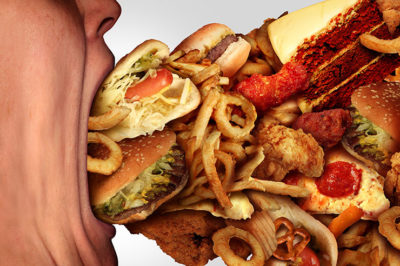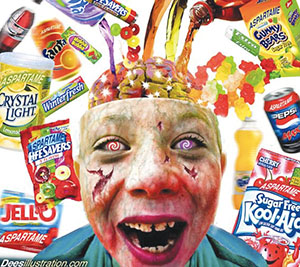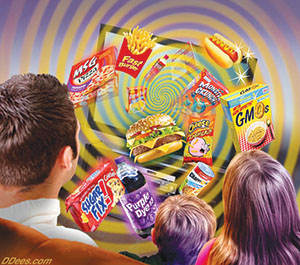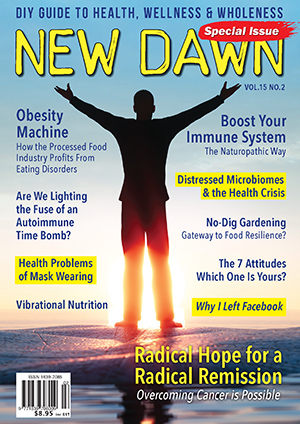From New Dawn Special Issue Vol 15 No 2 (Apr 2021)
Scientists, politicians, media, and health professionals note that Western countries face obesity and fatness epidemics. Large numbers of poor, malnourished children are obese because the cheap, processed, low-nutrient food bought by their parents – bread, cereals, snacks, etc. – contains high concentrations of sugars.
In addition to the systemic factors explored below, there are darker, more secretive reasons for our addiction to what the late philosopher-comedian George Carlin called “slow death by fast food.” But it is not just fast food. To save money on raw materials, sell innovation to other companies, and hook consumers onto their products, food giants have developed intricate supply lines for big firms like McDonald’s and PepsiCo. Using sophisticated design techniques based on the biology of pleasure and addiction, they have contributed to ill-health.
Obesity Epidemic
Obesity can cause serious health problems that lower life-quality, shorten it, and frequently lead to hospitalisation. Cushing’s disease (excess cortisol), polycystic ovary syndrome, and other ailments can cause obesity, as can depression. Usually, however, pathologies are caused by obesity. Typically, obesity results from the individual’s overeating, choice of foods, and lack of exercise. In most cases, obesity and weight gain do not appear to be solvable by the individual. Data suggest that most people who diet and exercise cannot lose weight and sustain their weight loss. Rather, weight-loss is typically achieved by a holistic change-of-life approach, not by dieting and exercising alone. This is partly because the system makes people revert to their old, sedentary lifestyles and partly because they are addicted to bad food. Only a comparatively small number of people can sustain weight loss without changing their approach to life and food. Obesity can cause, contribute to, or worsen cancer, coronary heart disease, gallbladder disease, high blood pressure, low-density lipoprotein cholesterol, sleep apnoea, and type-2 diabetes.
Systemic reasons for the obesity crisis include the unconscious, evolutionary flaw that makes people eat more than they need to in case they cannot eat again for a while. In nature, food can be scarce. In our artificial societies, it is abundant. Our brains developed to overeat in case of scarcity. Anthropologists note that once humans developed settled agriculture 10,000 years ago, obesity became a problem for the first time.
A related issue is that the human body is built for hunting and gathering. We are “born to run,” as anthropologists put it, yet modernity enforces sedentary living: the bus or car to work, sitting at a desk for most of the day, watching TV in exhaustion in the evening. Our intestines are now excessively long because our ancestors used to eat raw foods that took longer to digest. High-nutrient, fat-burning raw food diets are a niche, not the norm. The system has separated us from our environment: biodiversity is replaced by fields for monoculture, the nutrients in soils are depleted along with the pesticides and transport time, and the shelf-life of food lessens its nutritional quality. Work exhausts people and processed ready-meals are cheap. Corporate branding brainwashes us into reaching for high-sugar treats.
The epidemic of fatness and obesity has many consequences. Typically, overweight people are less happy and live shorter, unhealthy lives compared to thinner people. Morbidities including diabetes, heart disease, strokes, high blood pressure, and excess cholesterol often combine to make individuals more susceptible to death and injury from bacteria and viruses, including SARS-CoV-2.
The World Health Organization defines overweight and obese as excess fat accumulation relative to body mass index (BMI): “a person’s weight in kilograms divided by the square of [their] height in meters (kg/m2).” Overweight is BMI greater than or equal to 25 and obese 30. Globally, obesity relative to population increase has tripled since the 1970s. Nearly 2 billion adults are overweight and 650 million are obese. Relative to population size, the fattest populations on Earth tend to live on small islands: American Samoa, the Cook Islands, Kiribati, the Marshall Islands, Nauru, Palau, Samoa, Tokelau, and Tonga.
In Australia, nearly 70 per cent of adults are overweight: around half of whom are obese. Obesity is more common in older people. Poverty is a factor. Poor people are up to 40 per cent more likely to be obese than their wealthier counterparts. In the UK, nearly 70 per cent of men and 60 per cent of women are overweight. Of those, a quarter of men and a third of women are obese. Each year, around 800,000 British people are hospitalised with weight-related ailments: over 10,000 of which are directly related to obesity. Prevalence of obesity tends to be higher in the Midlands and in the Northeast of England around Durham, Hull, Lincolnshire, and Yorkshire. These areas correlate to deprivation and poverty. On average, over 50 per cent of Europeans are overweight or obese, with numbers varying from country to country: e.g., 36 per cent in Italy and 54 per cent in the Netherlands.
In the US, over 70 per cent of adults are overweight, of whom 42 per cent are obese. Twenty per cent of American children are obese. Areas in the US with the highest numbers of overweight and obese people include Memphis (TN), Shreveport (LA), Carmel (IN), Jackson (MS), and San Antonio (TX). These areas also correlate with high levels of poverty.
The most overweight countries in Asia are Malaysia (15 per cent obese), Brunei (14 per cent), Thailand (10 per cent), Indonesia (7 per cent), and the Philippines (6.5 per cent). Being in the top-five economies by GDP, Japan is a good country to compare with other so-called developed countries with big economies and high levels of poverty, such as European giants and the USA. Epidemiologists point to Japan’s traditional dietary habits as a reason for its comparatively low rate of obesity: 4 per cent compared to America’s 42 per cent. The Japanese consumption of fish, vegetables, and soybean products instead of dairy, fat, and meat is one explanation.
What’s On Your Plate?
When it comes to contributing to fatness and obesity, the usual suspects include food and beverage corporations whose products are loaded with bad fats, salt, and sugar: Burger King, Kellogg’s, KFC, McDonald’s, PepsiCo, and other big brands.
PepsiCo is worth $204bn and sells numerous brands. Crisps and potato chip brands include Cheetos, Doritos, Lay’s (Walkers in the UK), and Ruffles. Beverages include Aquafina bottled water, Mirinda fizzy orange, Mountain Dew, Pepsi, and Tropicana fruit drinks. Twenty-two such brands generate $1 billion a year for the company. Billions of people across 200 countries consume these for lunch at work, dinner at home, at parties, and when walking or shopping. PepsiCo spends over $2bn per annum on advertising. The cereal producer, Kellogg’s, owns the cracker brand Austin, the Nutrigrain bar, the crisps Pringles, and a number of sweet and savoury breakfast cereals including All-Bran, Coco Pops, Cornflakes, Crunchy Nut, Froot Loops, and Frosted Flakes. These and other products make Kellogg’s a $22bn company.
The Swiss firm Nestlé is worth $313bn. In addition to instant coffee, its products include baby food (Cerelac, Gerber, and NaturNes), bottle water (Perrier and S.Pellegrino), cereals (Cheerios, Fitness and Lion), confectionary (Aero, KitKat and Quality Street), instant meals (Buitoni pasta, Lean Cuisine diet and Stouffer’s frozen), and ice cream (Dreyer’s, Extrême and Häagen-Dazs). The company’s bottled water industry is worth $7bn a year. In 2005, Nestlé’s then-CEO, Peter Brabeck-Letmathe, said that many people think that, “as a human being you should have a right to water. That’s an extreme solution.” He added: “The other view says that water is a foodstuff like any other, and like any other foodstuff it should have a market value.” He concluded: “I believe it’s better to give a foodstuff a value.”
Globally, the baby formula industry is worth $11bn, including Nestlé’s products. Beginning in the 1970s, Nestlé targeted uneducated women in Africa and Latin America with marketing that led them to believe that artificially produced “scientific” baby milk formulae was more nourishing for their infants than breast milk. They also marketed their products as an example of social mobility, appealing to mothers’ yearning to escape absolute poverty. Nestlé hired women to play “nurses” who would call unexpectedly on mothers to sell them their formula. The fake nurses also told the mothers lies about how their natural milk would dry and that they’d be unable to feed their children. Dr Stephen Joseph of the pro-corporate US Agency for International Development said that baby formula killed a million children a year by depriving them of nutrition. It also led to stunted growth and brain damage among survivors.
These and other corporations use all manner of modified products in their foods. Sugar is a soluble carbohydrate that comes in several basic forms: galactose (found in a variety of products, including dairy), glucose (plant sugar), fructose (fruit sugar), and sucrose (cane sugar, a.k.a., granulated, regular, table). Added sugar is present in over 70 per cent of processed foods, including savoury products like bran cereals, bread, juice, and yoghurts. In the US, the Food and Drug Administration requires companies to list sugar in their ingredients. But companies use a loophole to disguise sugar as corn syrup, dextrose, fructose, maltose, rice syrup, and sucrose. Government corn subsidies in the 1970s gave food producers an abundance of cheap corn which they synthesised into an unhealthy, cost-saving replacement for natural sugars.
Starch is the carbohydrate used by plants for energy storage. Corn syrup (also known as glucose syrup) is starch converted to sugar. The process was invented by the chemist Gottlieb Kirchhoff in 1812. Today, most corn syrup is procured from No. 2 yellow dent corn, first grown in the US in 1846. Corn syrup is used as a thickener and as a cheaper alternative to cane sugar. High fructose corn syrup is commonly added to crackers, fizzy drinks, ready-meals, salad dressing, and sweetened juices. Caused by non-alcoholic fatty-liver disease, hepatocellular carcinoma is the most common type of liver cancer. Fructose has toxic effects on the liver, including increasing the production of fatty acid, insulin resistance, and oxidative stress. Fizzy drinks can raise bodily glucose, fructose, and insulin levels within 15 minutes of consumption. The body tries to convert fructose metabolism to glucose. In addition, the high concentrations of corn syrup in fizzy drinks contribute to type-2 diabetes.
Monosodium glutamate (MSG, a.k.a., sodium glutamate) is a natural salt in a variety of foods. Today, it is used as a synthetic flavour enhancer. In 1908, the chemist Kikunae Ikeda isolated brown crystals of glutamic acid, leading the way for the artificial production of MSG. MSG is present in crisps, dressings, fast foods, processed soups, and seasonings. Clinical studies compared hundreds of middle-aged to elderly people who have the same caloric intake and take the same amount of exercise. They found that those who have a high concentration of MSG in their diets tend to be susceptible to weight gain and obesity compared to those who eat little MSG.
So-called “trans fats” are emulsifiers: food additives that prolong shelf-life. They are produced naturally in dairy products, but they also occur when food manufacturers add hydrogen to vegetable oil (hydrogenated oil), which converts liquid into solid fats. Trans fats raise the level of low-density lipoprotein (LDL) cholesterol in the blood. Elevated levels of LDL do not easily dissolve and can increase the risk of Alzheimer’s, artery disease, heart attack, infertility, stroke, and type-2 diabetes. Collectively, trans fats constitute partially-hydrogenated oils, which the US Food and Drug Administration labelled unsafe in 2015. But trans fats are still found in processed bread, cakes, fast foods, margarine, pastries, snacks, and vegetable oils.
The Giants
It is easy to point the finger at McDonald’s, PepsiCo and the like, but from which companies do they acquire their modified additives? Kellogg’s, Nestlé, etc. typically purchase their flavour- and shelf-life-enhancing additives from other firms about which few people have heard. Enter the supply kingpins.
By 2020, the top ten global food companies and their values (in US dollars) included Cargill ($113.5bn), Archer Daniels Midland (ADM, $64.65bn), Sysco ($60bn), JBS ($51.7bn), and George Weston ($50bn). Scientists at these companies have spent decades perfecting the micro components of their foods to enhance flavour and addictiveness. The packaged products are then sold to food sellers, like KFC, whose scientists find innovative ways to synthesise them into their products.
Writing against these practices, Dr Steven Witherly developed a Food-Pleasure equation which posits that humans are addicted to junk food in part because Sensation (including taste like salt (MSG), smell, texture, and variety) are augmented by Caloric Stimulation (with proteins like gluteomorphins (gluten found in breads and cereals, etc.) and carbohydrates such as sugar, starch, and fat (including trans fats)). The stomach and small intestines contain receptors including mechanoreceptors and chemoreceptors, the latter are stimulated by amino acids, carbohydrates, and lipids. Using Doritos as an example, Witherly applies the equation and notes that the potato chip’s shape, dusty coating, combination of sugar and salt, plus high-fat saturation stimulate the consumer’s pleasure whilst increasing the amount of gut hormones that reduce anxiety. The same formula applies to KFC and other brands.
Cargill supplies many of the big food companies including KFC, McDonald’s, and PepsiCo. It sells 40 types of salt to food producers: flaked, ground, pulverised, smashed, and more. For instance, when popcorn producers buy from Cargill, they expect the shape of the salt to cling to every part of the textured popcorn kernel. Cheese and meat manufacturers buy Cargill salt because they want the ingredient to be as textureless as possible. In some products, a “flavour burst” is produced by processing the salt into micro-pyramid shapes.
In addition to allegedly making consumers addicted, Cargill has developed a shocking environmental and human rights record. In 2019, former US Congressman Henry A. Waxman’s Mighty Earth NGO infamously described Cargill as “the worst company in the world.” The company was founded in 1865 by the US businessman William Wallace Cargill whose descendants remain the controlling shareholders in the business. The original company was a grain-storage house in the frontier towns of Iowa. By the 1920s, operations had expanded to Italy and Canada. In 1938, it was banned from the Chicago Board of Trade for influencing grain prices. Today, Cargill employs 155,000 people in 70 countries and owns more than 60 subsidiaries. In addition to meats, oils, and salts, products include animal feed, bio-industrial, food ingredients, and proteins.
Founded in 1902, ADM provides products and services including animal feed, drinks, fuel, and industrial chemicals. It owns hundreds of subsidiaries worldwide include agro-investment firms, holding companies, trading partnerships, processing plants, and chemical manufactures. It brags: “We transform natural products into a complete portfolio of ingredients and flavours for foods and beverages, supplements, nutrition for pets and livestock and more.” ADM has at least “27 customer innovation centres in 21 different countries and a team of 400 food scientists.” ADM’s acidulants are used for flavour, colour, and moisture control. They include drums of citric acid (“non-GMO options available”), Citrisol® 501 to prevent off-colouration, sodium citrate dihydrate powders for emulsification, and potassium citrate for preservation. ADM supplies companies including Kellogg’s and PepsiCo.
Fake Food
“Sustainability” is the new buzzword among corporate conglomerates that have spent years ruining the Earth. Over the last few decades, food giants have merged to create mega-corporations, with many processed food suppliers like Tyson investing in smaller, organic firms. In the name of sustainability, they have a revolving door system, where the former CEO of one company joins the board of another. Advisory sessions are another feature. In September 2020, for instance, Ray Young, ADM’s Chief Financial Officer, shared a roundtable with, among others, Amy Senter, Vice President of Global Sustainability at Kellogg’s. The agenda included modifying food production in the name of greening up.
Recently, the multimillion-dollar asset manager, John Hancock Life Insurance, which owns tracts in Australia and Canada, sold land in the Columbia River Basin in the upper west of the USA to an anonymous investor, who journalists found out was the centibillionaire Bill Gates. The Basin contains unusually rich and tillable soil. The deal made Gates the biggest landowner in the US. Given his open support for genetically-modified organisms, it is possible that Gates will use the land to grow GMO crops. In addition, public money was used by NASA to develop fungus proteins. Using the technology, the company Nature’s Fynd developed a meat-free burger with proteins grown in the public Yellowstone National Park. The company raised $80 million from former US Vice President Al Gore’s Generation Investment Management and from Bill Gates’s Breakthrough Energy Ventures.
The solution to the crisis of fake food, GMOs, and addictive substances is to eat as little processed food as possible. Grocery stores have, over the last few decades, expanded their range of dairy-, gluten-, and GMO-free products to include organic foods. Support independent local health food shops and visit farmer’s markets. Social media is full of free, on-demand amateur and professional chefs who teach us how to cook healthy foods from scratch. Where possible, food can be grown in gardens and even in pots on windowsills and balconies, or if you haven’t a garden on an allotment, check for growers’ associations and local community gardens. Self-reliance and group-cultivation is great exercise, fresh air, and key to defeating fattening, poisonous, processed foods.
Footnotes
1. Centers for Disease Control and Prevention (US), www.cdc.gov/obesity/adult/causes.html
2. Ariana Chao (2014) Nursing Forum, 49(3): 189-99
3. David Miles (2006) The Tribes of Britain, Weidenfeld and Nicolson
4. Christopher McDougall (2009) Born to Run: A Hidden Tribe, Superathletes, and the Greatest Race the World Has Never Seen, Profile Books
5. Open Access Government 14 August 2019, www.openaccessgovernment.org/office-workers-sitting-down/71612
6. Karen Hardy et al. (2017) The Science of Nature, 104(2): link.springer.com/article/10.1007/s00114-016-1420-x
7. Donald R. Davis, Melvin D. Epp and Hugh D. Riordan (2004) Journal of the American College of Nutrition, 23(6): 669-82
8. World Health Organization, 1 April 2020, www.who.int/news-room/fact-sheets/detail/obesity-and-overweight
9. Alice Murphy, The Who (Australia), 10 Jan 2019, www.who.com.au/the-worlds-top-ten-fattest-countries
10. Australia Institute of Health and Welfare, 23 July 2020, www.aihw.gov.au/reports/australias-health/overweight-and-obesity
11. Cate Burns, Victoria Health Promotion Foundation, April 2004, www.vichealth.vic.gov.au/~/media/ResourceCentre/PublicationsandResources/healthy%20eating/Literature%20Review%20Poverty_Obesity_Food%20Insecurity.ashx
12. National Health Service, Statistics on Obesity, Physical Activity and Diet, 5 May 2020, digital.nhs.uk/data-and-information/publications/statistical/statistics-on-obesity-physical-activity-and-diet/england-2020
13. Graham Moon (2007) Social Science and Medicine, 65: 20-31
14. Save the Children quoted in Datablog, The Guardian, 23 February 2011, www.theguardian.com/news/datablog/2011/feb/23/child-poverty-britain-map
15. Eurostat, 2014, ec.europa.eu/eurostat/statistics-explained/index.php/Overweight_and_obesity_-_BMI_statistics
16. Centers for Disease Control and Prevention, National Center for Health Statistics, www.cdc.gov/nchs/fastats/obesity-overweight.htm
17. Rochie Bernardo, WalletHub, web.archive.org/web/20160323054225/https://wallethub.com/edu/fattest-cities-in-america/10532
18. PovertyUSA, www.povertyusa.org/data
19. Molly Moore, Statista, 9 Nov 2020, www.statista.com/statistics/1179519/asean-obesity-prevalence-by-country
20. GlobalData Healthcare, 28 Jan 2020, www.pharmaceutical-technology.com/comment/low-obesity-japan
21. Trading Economics, tradingeconomics.com/pep:us:market-capitalization
22. Sirsha Bhogaraju, Market Realist, 26 July 2020, marketrealist.com/2019/11/pepsico-a-must-know-overview-of-the-consumer-giant
23. A. Guttmann, Statista, 12 August 2020, www.statista.com/statistics/286547/pepsico-advertising-spending-worldwide
24. Kellogg Company, www.kelloggcompany.com/en_US/brandportfolio.html
25. Sky News, 28 Sept 2017, uk.news.yahoo.com/kelloggs-boss-john-bryant-step-195800506.html
26. Companies Market Cap, companiesmarketcap.com/nestle/marketcap
27. Nestlé, www.nestle.com/aboutus/overview/ourbrands
28. Quoted in Erwin Wagenhofer (2005) We Feed the World, Bullfrog Films
29. Jill Krasny, Business Insider, 25 June 2012, www.businessinsider.com/personal-finance/nestles-infant-formula-scandal-2012-6#the-baby-killer-blew-the-lid-off-the-formula-industry-in-1974-1
30. Darra Goldstein (2015) The Oxford Companion to Sugar and Sweets, Oxford University Press, 688
31. University of California San Francisco, sugarscience.ucsf.edu/hidden-in-plain-sight
32. Hopkins Medicine, www.hopkinsmedicine.org/health/wellness-and-prevention/finding-the-hidden-sugar-in-the-foods-you-eat
33. Tom Philpott, Mother Jones, 26 July 2020, www.motherjones.com/food/2019/07/the-secret-history-of-why-soda-companies-switched-from-sugar-to-high-fructose-corn-syrup
34. Katherine Marengo, Medical News Today, 29 May 2019, www.medicalnewstoday.com/articles/325315
35. Brittany Dewdney et al. (2020) Biomolecules, 10(4): 496
36. Mary E. Patterson et al. (2018) Journal of Nutrition and Intermediary Metabolism, 14: 1-7
37. Atsushi Yokota and Masato Ikeda (2011) Amino Acid Fermentation, Springer, p. v.
38. WebMD, www.webmd.com/diet/foods-high-in-msg
39. ScienceDaily, 14 August 2008, www.sciencedaily.com/releases/2008/08/080813164638.htm
40. Food and Drug Administration (US), www.fda.gov/food/food-additives-petitions/trans-fat
41. WebMD, www.webmd.com/heart-disease/ldl-cholesterol-the-bad-cholesterol
42. FDA, www.fda.gov/food/food-additives-petitions/final-determination-regarding-partially-hydrogenated-oils-removing-trans-fat
43. Diabetes.co.uk, 15 Jan 2019, www.diabetes.co.uk/food/trans-fats.html
44. Food Processing Technology, 6 Nov 2020, www.foodprocessing-technology.com/features/top-ten-food-companies-in-2020
45. Steven A. Witherly (2007) Why Humans Like Junk Food: The Inside Story on Why You Like Your Favorite Foods, the Cuisine Secrets of Top Chefs, and How to Improve Your Own Cooking Without a Recipe!, iUniverse
46. FoodIngredientsFirst.com, 17 May 2012, www.foodingredientsfirst.com/news/kfc-introduces-homegrown-canola-oil.html
47. Cargill, 21 March 2016, www.cargill.com/story/cargill-and-mcdonalds-france-partner-with-french-poultry-farmers
48. Cargill, 1 January 2015, www.cargill.com/history-story/en/THIRD-BAY-PEPSI.jsp
49. Michael Moss (2013) Salt, Sugar, Fat: How the Food Giants Hooked Us, W.H. Allen, 286-87
50. Mighty Earth (2019) The worst company in the world, www.mightyearth.org/wp-content/uploads/Mighty-Earth-Report-Cargill-The-Worst-Company-in-the-World-July-2019.pdf
51. Banktrack, www.banktrack.org/company/cargill
52. Neil Weinberg with Brandon Copple, Forbes, 25 Nov 2002, web.archive.org/web/20021115202802/https://www.forbes.com/forbes/2002/1125/158.html
53. Cargill, www.cargill.com/about/company-overview
54. Securities and Exchange Commission, 31 Dec 2018, www.sec.gov/Archives/edgar/data/7084/000000708419000012/adm-ex21_20181231x10k.htm
55. ADM, www.adm.com/our-company
56. ADM, www.adm.com/news/stories/adms-wright-named-a-woman-worth-watching-in-stem
57. ADM, www.adm.com/products-services/food/acidulants
58. ADM, www.adm.com
59. Ibid.
60. Anna Wiber, Baking Business, 13 March 2018, www.bakingbusiness.com/articles/45738-how-general-mills-kellogg-keep-ingredient-supply-chains-transparent
61. ADM, 6 May 2013, www.adm.com/news/news-releases/adm-cocoa-receives-supplier-of-the-year-award-from-pepsico-mexico
62. Andy Coyne, 15 Dec 2017, www.just-food.com/analysis/2017-the-year-in-food-industry-ma_id138359.aspx
63. ADM, 16 Sept 2020, www.adm.com/news/news-releases/adm-and-cdp-launch-climate-week-with-panel-on-esg-and-business-performance
64. Eric OKeefe, “Bill Gates: America’s Top Farmland Owner,” Land Report, 11 Jan 2021, landreport.com/2021/01/bill-gates-americas-top-farmland-owner
65. Katherine Davis, Business Journals, 16 Feb 2021, www.bizjournals.com/chicago/inno/stories/news/2021/02/16/bill-gates-backed-food-startup-reveals-products.html
66. Jonathan Shieber, Techcrunch, 15 Feb 2020, techcrunch.com/2021/02/15/after-raising-150-million-in-equity-and-debt-natures-fynd-opens-its-fungus-food-for-pre-orders
© New Dawn Magazine and the respective author.
For our reproduction notice, click here.





